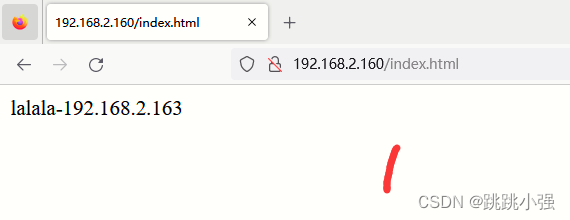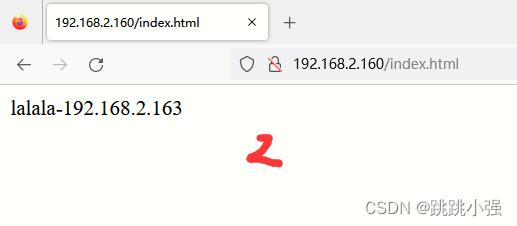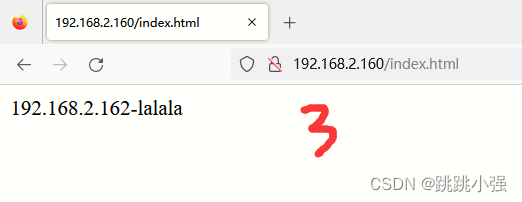反向代理的概念
代理一词,顾名思义就是代为处理,正向代理就是代替客户端处理,代替客户端进行各种服务的访问以及获取。那么反向代理自然就是代替服务器进行事务处理,即就是此时的代理服务器负责将用户的各项请求做一个汇总,分类,将其分发到不同的服务器上去进行处理。从而达到负载均衡和隐匿真实服务器的作用。
nginx作为性能怪兽,其最优秀的功能便是对反向代理的完美支持,本文将结合示例,了解反向代理的基本配置。
nginx的负载均衡策略
负载均衡用于从“upstream”模块定义的后端服务器列表中选取一台服务器接受用户的请求。一个最基本的upstream模块是这样的,模块内的server是服务器列表:
#动态服务器组
upstream dynamic_zuoyu {
server localhost:8080; #tomcat 7.0
server localhost:8081; #tomcat 8.0
server localhost:8082; #tomcat 8.5
server localhost:8083; #tomcat 9.0
}
在upstream模块配置完成后,要让指定的访问反向代理到服务器列表:
#其他页面反向代理到tomcat容器
location ~ .*$ {
index index.jsp index.html;
proxy_pass http://dynamic_zuoyu;
}
上文的大概意思就是从upstream模块种选取server中的一个用于某次客户请求的处理,那么如何选取处理请求的服务器便成为了一个十分重要的问题,为此nginx给出了一下几种方式;
| 轮询 | 默认方式 |
|---|---|
| weight | 权重方式 |
| ip_hash | 依据ip分配方式 |
| least_conn | 最少连接方式 |
| fair(第三方) | 响应时间方式 |
| url_hash(第三方) | 依据URL分配方式 |
1.轮询
最基本的配置方法,上面的例子就是轮询的方式,它是upstream模块默认的负载均衡默认策略。每个请求会按时间顺序逐一分配到不同的后端服务器。
参数如下:
fail_timeout — 与max_fails结合使用。
max_fails — 设置在fail_timeout参数设置的时间内最大失败次数,如果在这个时间内,所有针对该服务器的请求都失败了,那么认为该服务器会被认为是停机了,
fail_time — 服务器会被认为停机的时间长度,默认为10s。
backup — 标记该服务器为备用服务器。当主服务器停止时,请求会被发送到它这里。
down — 标记服务器永久停机了。
注意:
- 在轮询中,如果服务器down掉了,会自动剔除该服务器。
- 缺省配置就是轮询策略。
- 此策略适合服务器配置相当,无状态且短平快的服务使用。
2.weight
权重方式,在轮询策略的基础上指定轮询的几率。例子如下:
upstream dynamic_zuoyu {
server localhost:8080 weight=2; #tomcat 7.0
server localhost:8081; #tomcat 8.0
server localhost:8082 backup; #tomcat 8.5
server localhost:8083 max_fails=3 fail_timeout=20s; #tomcat 9.0
}
在该例子中,weight参数用于指定轮询几率,weight的默认值为1,;weight的数值与访问比率成正比,比如Tomcat 7.0被访问的几率为其他服务器的两倍。
注意:
- 权重越高分配到需要处理的请求越多。
- 此策略可以与least_conn和ip_hash结合使用。
- 此策略比较适合服务器的硬件配置差别比较大的情况。
3.ip_hash
指定负载均衡器按照基于客户端IP的分配方式,这个方法确保了相同的客户端的请求一直发送到相同的服务器,以保证session会话。这样每个访客都固定访问一个后端服务器,可以解决session不能跨服务器的问题。
#动态服务器组
upstream dynamic_zuoyu {
ip_hash; #保证每个访客固定访问一个后端服务器
server localhost:8080 weight=2; #tomcat 7.0
server localhost:8081; #tomcat 8.0
server localhost:8082; #tomcat 8.5
server localhost:8083 max_fails=3 fail_timeout=20s; #tomcat 9.0
}
注意:
- 在nginx版本1.3.1之前,不能在ip_hash中使用权重(weight)
- ip_hash不能与backup同时使用。
- 此策略适合有状态服务,比如session。
- 当有服务器需要剔除,必须手动down掉。
4.least_conn
把请求转发给连接数较少的后端服务器。轮询算法是把请求平均的转发给各个后端,使它们的负载大致相同;但是,有些请求占用的时间很长,会导致其所在的后端负载较高。这种情况下,least_conn这种方式就可以达到更好的负载均衡效果。
#动态服务器组
upstream dynamic_zuoyu {
least_conn; #把请求转发给连接数较少的后端服务器
server localhost:8080 weight=2; #tomcat 7.0
server localhost:8081; #tomcat 8.0
server localhost:8082 backup; #tomcat 8.5
server localhost:8083 max_fails=3 fail_timeout=20s; #tomcat 9.0
}
注意:此负载均衡策略适合请求处理时间长短不一造成服务器过载的情况。
5.第三方策略
5.1 fair
按照服务器端的响应时间来分配请求,响应时间短的优先分配.
#动态服务器组
upstream dynamic_zuoyu {
server localhost:8080; #tomcat 7.0
server localhost:8081; #tomcat 8.0
server localhost:8082; #tomcat 8.5
server localhost:8083; #tomcat 9.0
fair; #实现响应时间短的优先分配
}
5.2 url_hash
按访问url的hash结果来分配请求,使每个url定向到同一个后端服务器,要配合缓存命中来使用。同一个资源多次请求,可能会到达不同的服务器上,导致不必要的多次下载,缓存命中率不高,以及一些资源时间的浪费。而使用url_hash,可以使得同一个url(也就是同一个资源请求)会到达同一台服务器,一旦缓存住了资源,再此收到请求,就可以从缓存中读取。
#动态服务器组
upstream dynamic_zuoyu {
hash $request_uri; #实现每个url定向到同一个后端服务器
server localhost:8080; #tomcat 7.0
server localhost:8081; #tomcat 8.0
server localhost:8082; #tomcat 8.5
server localhost:8083; #tomcat 9.0
}
nginx反向代理的配置方法
1.环境配置
准备三台配置了nginx的服务器。

在1/2上分别配置不同的web页面
#关闭防火墙
[root@blackstone ~]# systemctl stop firewalld
[root@blackstone ~]# systemctl disable firewalld
#初始化配置文件
[root@blackstone ~]# rm -f /etc/nginx/nginx.conf
[root@blackstone ~]# cp /usr/local/nginx/conf/nginx.conf.default /etc/nginx/nginx.conf
[root@blackstone ~]# vim /etc/nginx/nginx.conf
--------------------------------------------------------------
#将配置文件内部的此行修改以指定工作目录(网页根目录)
location / {
root /var/www/html; #指定根目录
index index.html index.htm;
}
--------------------------------------------------------------
#写入网页
[root@blackstone ~]# mkdir -p /var/www/html
[root@blackstone ~]# echo lalala-192.168.2.163 > /var/www/html/index.html
#启动nginx
[root@blackstone ~]# nginx
另一台服务器相同配置。


2.反向代理配置
在第三台服务器上配置反向代理
[root@blackstone ~]# rm -f /etc/nginx/nginx.conf
[root@blackstone ~]# cp /usr/local/nginx/conf/nginx.conf.default /etc/nginx/ngin x.conf
[root@blackstone ~]# vim /etc/nginx/nginx.conf
示例配置文件:
#user nobody;
worker_processes 1;
#error_log logs/error.log;
#error_log logs/error.log notice;
#error_log logs/error.log info;
#pid logs/nginx.pid;
events {
worker_connections 1024;
}
http {
include mime.types;
default_type application/octet-stream;
#log_format main '$remote_addr - $remote_user [$time_local] "$request" '
# '$status $body_bytes_sent "$http_referer" '
# '"$http_user_agent" "$http_x_forwarded_for"';
#access_log logs/access.log main;
sendfile on;
#tcp_nopush on;
#keepalive_timeout 0;
keepalive_timeout 65;
#gzip on;
#负载均衡策略配置
upstream nginx_reverse{
# 30s内检查心跳发送两次包,未回复就代表该机器宕机,请求分发权重比为1:2
server 192.168.2.162 weight=100 max_fails=2 fail_timeout=30s;
server 192.168.2.163 weight=200 max_fails=2 fail_timeout=30s;
# 这里的IP请配置成你WEB服务所在的机器IP
}
server {
listen 80;
server_name localhost;
#charset koi8-r;
#access_log logs/host.access.log main;
#error_page 404 /404.html;
# redirect server error pages to the static page /50x.html
#
error_page 500 502 503 504 /50x.html;
location = /50x.html {
root html;
}
# proxy the PHP scripts to Apache listening on 127.0.0.1:80
#
#location ~ \.php$ {
# proxy_pass http://127.0.0.1;
#}
# pass the PHP scripts to FastCGI server listening on 127.0.0.1:9000
#
#location ~ \.php$ {
# root html;
# fastcgi_pass 127.0.0.1:9000;
# fastcgi_index index.php;
# fastcgi_param SCRIPT_FILENAME /scripts$fastcgi_script_name;
# include fastcgi_params;
#}
# deny access to .htaccess files, if Apache's document root
# concurs with nginx's one
#
#location ~ /\.ht {
# deny all;
#}
#再此处使用location调用负载均衡策略
location / {
#设置根目录
root /var/www/html;
index index.html index.htm;
proxy_set_header Host $host;
proxy_set_header X-Real-IP $remote_addr;
proxy_set_header X-Forwarded-For $proxy_add_x_forwarded_for;
# 请求交给名为nginx_reverse的upstream上
proxy_pass http://nginx_reverse;
}
}
# another virtual host using mix of IP-, name-, and port-based configuration
#
#server {
# listen 8000;
# listen somename:8080;
# server_name somename alias another.alias;
# location / {
# root html;
# index index.html index.htm;
# }
#}
# HTTPS server
#
#server {
# listen 443 ssl;
# server_name localhost;
# ssl_certificate cert.pem;
# ssl_certificate_key cert.key;
# ssl_session_cache shared:SSL:1m;
# ssl_session_timeout 5m;
# ssl_ciphers HIGH:!aNULL:!MD5;
# ssl_prefer_server_ciphers on;
# location / {
# root html;
# index index.html index.htm;
# }
#}
}
配置完毕后重启nginx
[root@blackstone ~]# nginx -t
nginx: the configuration file /etc/nginx/nginx.conf syntax is ok
nginx: configuration file /etc/nginx/nginx.conf test is successful
[root@blackstone ~]# nginx -s reload
进行测试:



可以看到三次刷新我们的请求被发送到了两台服务器,占比为1:2
3.关于location的细节
nginx的配置是分块分层级进行的,最外层的块分为三个,分别是全局块、events块和http块。
在http块中又有server块是用来指定虚拟主机的模块,其中我们可以通过对location块的配置基于 Nginx 服务器接收到的请求字符串(例如 server_name/uri-string),对虚拟主机名称(也可以是 IP 别名)之外的字符串(例如 前面的 /uri-string)进行匹配,对特定的请求进行处理。地址定向、数据缓存和应答控制等功能,还有许多第三方模块的配置也在这里进行。
http {
include mime.types;
default_type application/octet-stream;
sendfile on;
keepalive_timeout 65;
server {
listen 80;
server_name localhost;
# 若请求路径像这样:www.xxxx/img/example.png
# 则访问/img/目录下的文件时,nginx会去/var/www/image/img/目录下找文件,就是对于网站的根目录进行指定
location /img/ {
root /var/www/image;
}
error_page 500 502 503 504 /50x.html;
location = /50x.html {
root html;
}
}
当然我们在浏览其他的博客时可能会发现,在location后边会附有一些特殊的符号;
location [ = | ~ | ~* | ^~] URL {...}
这里紧跟着的符号也是大有作用的:
| = | 用于不含正则表达式的 uri 前,要求请求字符串与 uri 严格匹配,如果匹配成功,就停止继续向下搜索并立即处理该请求 |
|---|---|
| ~ | 用于表示 uri 包含正则表达式,并且区分大小写 |
| ~* | 用于表示 uri 包含正则表达式,并且不区分大小写 |
| ^~ | 用于不含正则表达式的 uri 前,要求 Nginx 服务器找到标识 uri 和请求字符串匹配度最高的 location 后,立即使用此 location 处理请求,而不再使用 location块中的正则 uri 和请求字符串做匹配。 |
这里需要注意的是我们在使用正则表达式进行URL匹配时,前面一定要添加~或者~*
本文参考链接:
nginx的负载均衡策略
nginx配置—反向代理






















 554
554











 被折叠的 条评论
为什么被折叠?
被折叠的 条评论
为什么被折叠?








